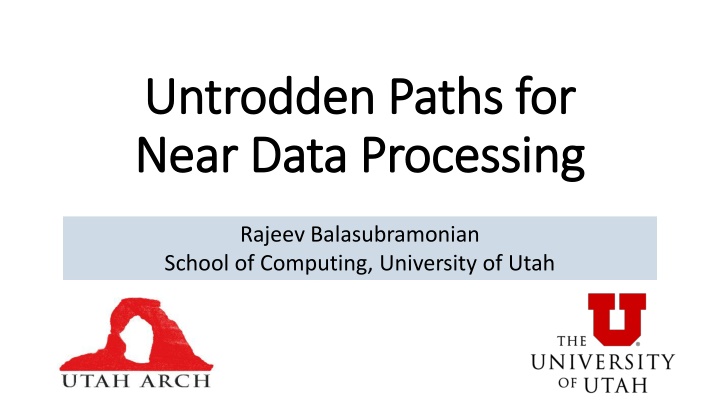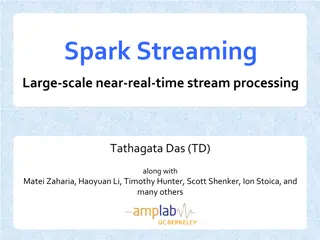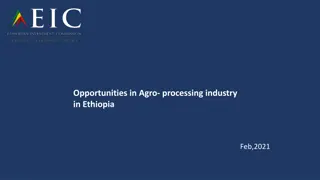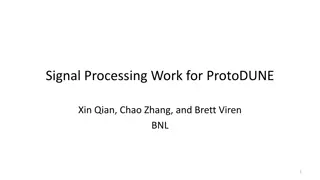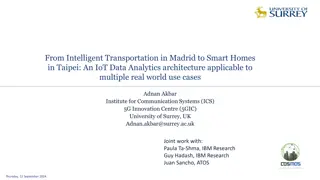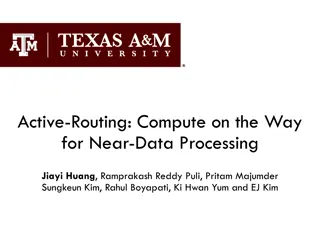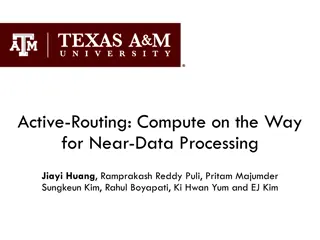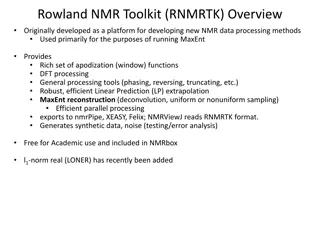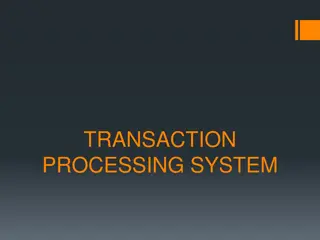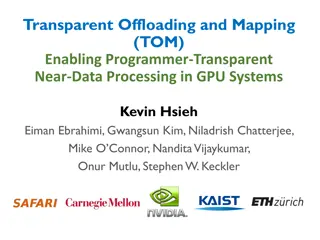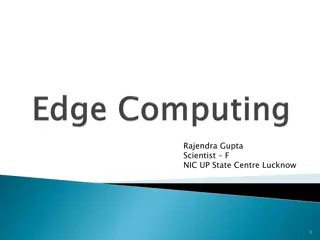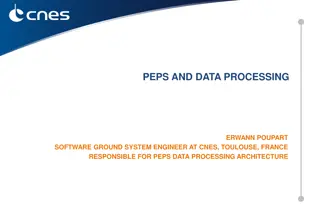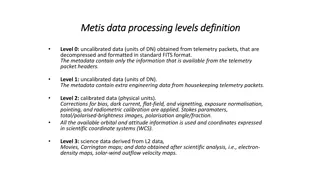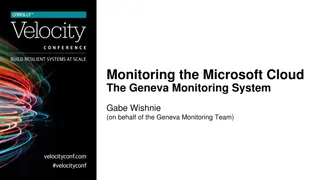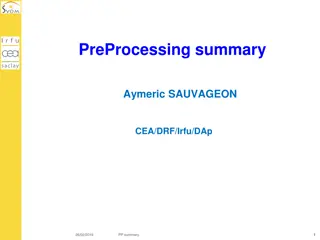Untrodden Paths for Near Data Processing
Near data processing has seen a significant evolution, marked by key inflection points and technological innovations. From the emergence of in-situ acceleration to the development of feature-rich DIMMs and near-data security strategies, this field has witnessed a transformation driven by necessities for improved efficiency and performance. The utilization of memristors, machine learning acceleration techniques, and challenges such as high ADC power consumption and precision requirements further highlight the complexity and opportunities within this domain. Explore the dynamic landscape of near data processing as it continues to shape the future of computing.
Download Presentation

Please find below an Image/Link to download the presentation.
The content on the website is provided AS IS for your information and personal use only. It may not be sold, licensed, or shared on other websites without obtaining consent from the author.If you encounter any issues during the download, it is possible that the publisher has removed the file from their server.
You are allowed to download the files provided on this website for personal or commercial use, subject to the condition that they are used lawfully. All files are the property of their respective owners.
The content on the website is provided AS IS for your information and personal use only. It may not be sold, licensed, or shared on other websites without obtaining consent from the author.
E N D
Presentation Transcript
Untrodden Paths for Untrodden Paths for Near Data Processing Near Data Processing Rajeev Balasubramonian School of Computing, University of Utah
Near Data Processing Present Day Expectations 1995 2005 Time Peak of Inflated Expectations Plateau of Productivity The Gartner Hype Curve 2
Zooming In Expectations Zero novelty See PIM 2011-2013: Many rejected papers Too costly See DRAM vendors Time Plateau of Productivity The Gartner Hype Curve 3
The Inflection Point Inspired the term Near Data Processing Micron s Hybrid Memory Cube Spawned the Workshop on NDP, 2013-2015 IEEE Micro Article, 2014 IEEE Micro Special Issue on NDP, 2016 4
The Inflection Point Micron s Hybrid Memory Cube A low-cost approach to data/compute co-location 5
Low-Cost? Demands a diversified portfolio 6
Talk Outline 1. In-situ acceleration 2. Feature-rich DIMMs BoB MC Processor 3. Near-data security 7 Image source: gizmodo
In-Situ Operations x0 w00 w01 w02 w03 V1 G1 x1 w10 w11 w12 w13 I1 = V1.G1 x2 w20 w21 w22 w23 V2 G2 x3 w30 w31 w32 w33 I2 = V2.G2 y0 y1 y2 y3 I = I1 + I2 = V1.G1 + V2.G2 9
Machine Learning Acceleration T T T T OR OR MP S+A ADC ADC ADC ADC DAC eDRAM Buffer XB T T T T S+A IR S+H T T T T IMA IMA IMA IMA DAC XB T T T T IMA IMA IMA IMA S+H EXTERNAL IO INTERFACE CHIP (NODE) In-Situ Multiply Accumulate TILE Low leakage No Storage vs. Compute No weight fetch 10
DaDianNao 11
Challenges High ADC power Difficult to exploit sparsity Precision and noise Other workloads 12
Focusing on Cost Commodity DDR3 DRAM 70 pJ/bit Commodity LPDDR2 40 pJ/bit GDDR5 14 pJ/bit HMC data access 10.5 pJ/bit HMC SerDes links 4.5 pJ/bit HBM data access 3.6 pJ/bit HBM interposer link 0.3 pJ/bit References: Malladi et al., ISCA 12 Jeddeloh & Keeth, Symp. VLSI 12 O Connor et al. MICRO 17 Image source: HardwareZone 13
Memory Interconnects Wang et al., HPCA 2018 Pugsley et al., IEEE Micro 2014 BoB Processor MC 1. Interconnect architecture 2. Computation off-loading (what, where) 3. Auxiliary functions: coding, compression, encryption, etc. 14
Talk Outline 1. In-situ acceleration 2. Feature-rich DIMMs BoB MC Processor 3. Near-data security 15 Image source: gizmodo
Memory Vulnerabilities Malicious OS or hardware can modify data Processor OS VM 1 CORE 1 Victim MC VM 2 CORE 2 Attacker All buses are exposed 16
Spectre Overview x is controlled by attacker Thanks to bpred, x can be anything array1[ ] is the secret if (x < array1_size) y = array2[ array1[x] ]; Victim Code 5 10 20 SECRETS array1[ ] Access pattern of array2[ ] betrays the secret array2[ ] 17
Memory Defenses Memory timing channels Requires dummy memory accesses overhead of up to 2x Memory access patterns Requires ORAM semantics overhead of 280x Memory integrity Requires integrity trees and MACs overhead of 10x Prime candidate for NDP! 18
InvisiMem, ObfusMem Exploits HMC-like active memory devices MACs, deterministic schedule, double encryption Easily handles integrity, timing channels, trace leakage 19 From Awad et al., ISCA 2017
Path ORAM Leaf 17 Data 0x1 17 0x1 25 Data Step 1. Check the PosMap for 0x1. Step 2. Read path 17 to stash. CPU 0x0 0x1 17 25 Step 3. Select data and change its leaf. Step 4. Write back stash to path 17. 0x2 0x3 PosMap Stash 20
Distributed ORAM with Secure DIMMs Authenticated buffer chip 1. ORAM operations shift from Processor to SDIMM. 2. ORAM traffic pattern shifts from the memory bus to on-SDIMM private buses. 3. Bandwidth # SDIMMs. 4. No trust in memory vendor. 5. Commodity low-cost DRAM. Processor MC All buses are exposed Buffer chip and processor communication is encrypted 21
SDIMM: Independent Protocol ORAM split into 2 subtrees Steps: 1. ACCESS(addr,DATA) to ORAM0. 2. Locally perform accessORAM. CPU sends PROBE to check. 3. CPU sends FETCH_RESULT. New leaf ID assigned in CPU. 4. CPU broadcasts APPEND to all SDIMMs to move the block. ORAM0 2 4 1 3 ORAM1 4 CPU 22
SDIMM: Split Protocol A B C D M SDIMM 1 SDIMM 0 A1 B1 C1 D1 M1 A0 B0 C0 D0 M0 Even bits of Data/Meta Odd bits of Data/Meta 23
SDIMM: Split Protocol 1. Read a path to local stashes. 1 5 2. Send metadada to CPU. 3. Re-assemble and decide writing order. 2 1 5 4. Send metadata back to SDIMMs. 0 4 5. Write back the path based on the order determined by CPU. 3 24
Take-Homes NDP is the key to reduced data movement 3D-stacked memory+logic devices are great, but expensive! Need diversified efforts: New in-situ computation devices Focus on traditional memory and interconnects Focus on auxiliary features: security/privacy, compression, coding Acks: Utah Arch students: Ali Shafiee, Anirban Nag, Seth Pugsley Collaborators: Mohit Tiwari, Feifei Li, Viji Srinivasan, Alper Buyuktosunoglu, Naveen Muralimanohar, Vivek Srikumar Funding: NSF, Intel, IBM, HPE Labs. 25
